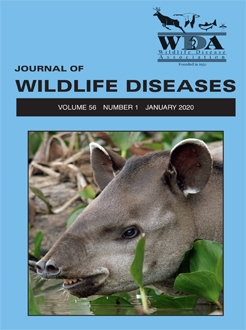Declining population sizes of koalas (Phascolarctos cinereus) in SE Queensland (QLD), Australia can partially be attributed to chlamydiosis, with the majority of epidemiological studies focusing on the prevalence of infection and associated pathology in female koalas, with lesser attention given to males. We aimed to explore the epidemiology of Chlamydia pecorum infection in the male urogenital tract from wild (hospitalized and free-ranging) koalas in SE QLD. Although 67% of male koalas were infected with C. pecorum in their urogenital tract and 55% were shedding the organism in their semen, only a third of the males sampled presented with overt signs of urogenital disease. Infection with C. pecorum was lower in populations from rural locations, compared with periurban locations, with a corresponding low association between urogenital infection and clinical disease. The presence of C. pecorum in penile urethral swabs was a good predictor of the presence of C. pecorum in semen, with a significant correlation (P=0.006) in 58% of males. In contrast, the C. pecorum load in penile urethral swabs was not a good predictor of the C. pecorum load in semen, with no significant correlation. In addition, 57% of male koalas had large numbers of bacterial copy numbers in the penile urethra (upper quartile) and 40% shedding into semen with no overt signs of disease. Investigation of the association of C. pecorum infection, body condition score, and age revealed that the highest incidence of urogenital infection occurred in males with the lowest body score (1 out of 10). Furthermore, 63% of sexually mature male koalas (>2 yr old) had urethral infections and 50% had C. pecorum in their semen. Our study suggested that the role of chlamydia in male koala infertility has been previously underestimated.
How to translate text using browser tools
6 January 2020
EPIDEMIOLOGY OF CHLAMYDIA-INDUCED REPRODUCTIVE DISEASE IN MALE KOALAS (PHASCOLARCTOS CINEREUS) FROM SOUTHEAST QUEENSLAND, AUSTRALIA AS ASSESSED FROM PENILE URETHRAL SWABS AND SEMEN
Lyndal S. Hulse,
Kenneth Beagley,
William Ellis,
Sean Fitzgibbon,
Amber Gillett,
Ben Barth,
Amy Robbins,
Michael Pyne,
Rebecca Larkin,
Stephen D. Johnston
ACCESS THE FULL ARTICLE

Journal of Wildlife Diseases
Vol. 56 • No. 1
January 2020
Vol. 56 • No. 1
January 2020
Chlamydia pecorum
epidemiology
koala
pathology
penile urethra
semen




